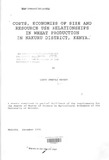| dc.description.abstract | Wheat production in Kenya has slumped during the last two
decades due to among other factors the high cost of productisn and
subdivision of former large-scale wheat farms. The broad objective
of this study was to examine cost behaviour under the prevailing
production environment of wheat industry to help identify ways of
overcoming this discouraging situation. Three hypotheses were
tested. These were: that rate of wheat output has no significant
effect on cost; that size of wheat enterprise does not
significantly affect cost; and that degree of wheat specialization
has no significant effect on cost. Both primary and secondary data
were used for the analysis. The secondary data was obtained from
national agricultural reports while primary data was obtained from
a farm survey using a questionnaire administered on a sample of 80
wheat farmers in Nakuru District. The method of Ordinary Least
Squares (OLS) was used to estimate the cost functions using crosssection
data of the wheat industry over the 1992 production season.
Results showed that costs of wheat production on small-scale
farms are high compared to production on large-scale farms. Average
costs per tonne of wheat produced on small- and large-scale were
kshs 12,666.40 and Kshs 502.60 respectively. This average cost
declined significantly for the rising size of wheat enterprise,
level of managerial skills of entrepreneur, dairy activities on
wheat farms and usage of own machinery. Average cost also decreased
with increasing output level implying that increased yields lead to
low costs. However, average cost rose significantly with increasing
crop activities on wheat farms. The significant costs in wheat
production were found to be on land preparation, harvesting and
labour. Wheat exhibited complementary and supplementary
relationships with dairy enterprise in the use of resources.
However, the combination of the wheat enterprise and other crop
enterprises exhibited competition in use of most resources apart
from machinery and labour where supplementary relationship was
observed. Wheat was found to be a decreasing cost industry
demonstrating existence of substantial economies of size. The wheat
industry achieved both pecuniary economies and real economies.
Pecuniary economies were realised from paying lower prices for the
factors used in wheat production due to bulk-buying by the farmer
as the enterprise size increased. The significant real economies
realised in wheat production arose from labour (labour economies) ,
fixed capital (machinery economies) and land (land economies) .
It was recommended that production at reduced cost can be
carried out by adopting several alternative types of farm
organisational adjustments. These involve seeding of more land
under wheat to exploit the substantial economies of size that exist
in wheat farming, combination of wheat with complementary
enterprises like dairy that lead to saving and optimal utilization
of resources, and ownership of machinery used in wheat production.
Appropriate technology suited for small-scale wheat production
conditions should be designed and fa,rmers should be encouraged to
increase their operational scales throuqh lease or purchase to
exploit economies of size that exist in the industry. | en |

